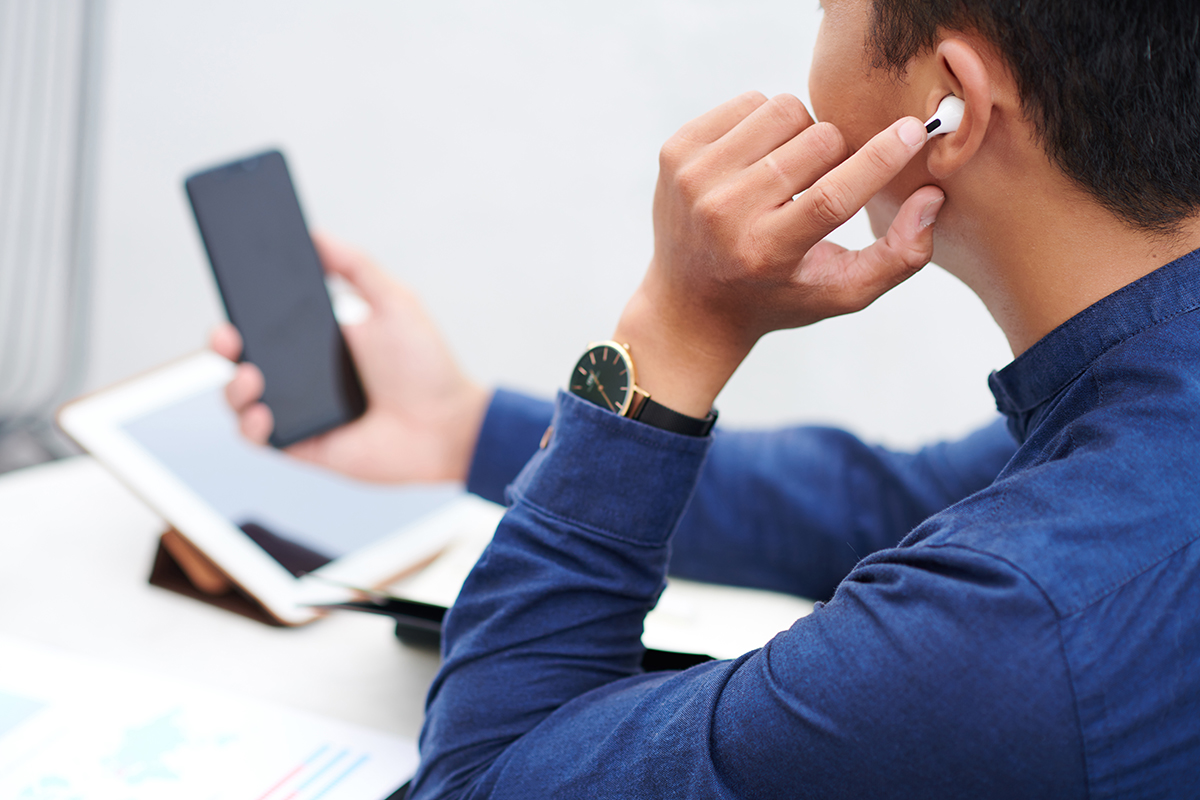
Hearables have come a long way in the last few decades. From the bulky, Princess Leia-esque headphones of the 70s to the sleek, sophisticated wireless earbuds found on the market today, hearable technology has zipped lightyears beyond what music lovers could have dreamed of even twenty years ago.
In 2021, sales of true wireless hearables (TWS) were around 310 million units worldwide. Apple® has led the market for the last few years, with over 40% market share in 2020, but the rest of the market is now starting to make ground, having recognized the popular demand for quality smart wireless hearables.
So why have smart wireless hearables become so popular? And, in what way can the current technology be improved? Let’s take a look at the pros and cons of smart wireless hearables.
The Advantages

- Portability
One of the main advantages of smart wireless hearables is their incredible portability. They can be taken almost anywhere, as they don’t take up much space in a purse or a travel bag. They can simply sit neatly in the ears without any twisted, dangling wires getting in the way.
An office manager can take business calls while walking around to pick up mail or wander out of the office without ever disconnecting or packing up anything. This makes smart wireless hearables enable a seamless portable listening experience while keeping the user more productive. - Reduction
Some smart wireless hearables also provide the added benefit of noise reduction. For example, earbud brands like Apple’s AirPods Pro® and Samsung’s Galaxy Buds® Pro both have active noise cancellation options that enable users, such as studying students and exhausted parents, to turn off the outside world and experience almost complete silence.
Many other wireless hearables models also offer similar noise reduction features, including many over-ear wireless headphones. Noise reduction is a key feature for people working in busy offices or commuting on loud train services. Equally, it is great for people who simply desire a bit of peace and quiet every now and again. - Convenience
The convenience of being able to use smart wireless hearables cannot be overstated. Users no longer have to be physically wired to a device while listening to music or enjoying a podcast. Everything can be done wireless on the go while receiving a full listening experience.
Many smart wireless hearables are also equipped with a microphone, allowing users to make or take phone calls and record voice notes and reminders with ease. - Advanced Features
One of the biggest advantages of smart wireless hearables is the ability and opportunity to have advanced features that cover a wide range of applications. That includes health monitoring, heart rate monitoring, entertainment, guidance, and other cloud-based communications.
The Disadvantages

- Battery Life
Unlike standard wired earphones and headphones, smart wireless hearables need to be charged. So, while a user may have greater portability with wireless hearables, their limited battery life means that this freedom will only last for so long. If the user anticipates heavy usage, like gaming online for a few hours, it’s probably a good idea to keep a charging station nearby.
In general, the biggest brands on the market like Apple, Sony®, and Panasonic® offer between 6-10 hours of continuous use. This limited battery life is an obvious disadvantage of wireless hearables because it reduces convenience. - Delay
Wireless hearables function via Bluetooth®. As a result, there is sometimes a delay between what is being played and what is being heard. This delay is also sometimes referred to as ‘lag’ because the sound received lags behind what is being played.
If the user is only using the wireless hearables to listen to music, this delay – which is usually very minimal – will not really impact the listening experience. However, if the user uses wireless earbuds or headphones for gaming or production, these latency issues may prevent them from getting the desired experience. - Connectivity Issues
To use any smart wireless hearables, the user has to pair and connect them to the device being used. For a wired device, this process is easy, and just plug the cord into the phone or computer, and the sound is right there. However, this process is slightly more complicated with wireless hearables.
One of the key disadvantages of wireless hearables is that Bluetooth connectivity with personal devices can be inconsistent and mysteriously interrupted. Overall, most modern wireless hearables have excellent connectivity, but it can be frustrating if pairing and connecting the device becomes an issue. - Moisture Issues (rain/sweat)
All wireless hearable manufacturers have to consider vulnerability to moisture when designing their products since these devices are often used outside and when people are on-the-go. Both rain and sweat can result in signal interference.
Indeed, as with most electrical products, wireless hearables work best in dry environments. Most modern wireless hearables are relatively durable, but their vulnerability to moisture is definitely a disadvantage worth considering.
How Ambiq Contributes
Ultra-low power microprocessors from Ambiq® are revolutionizing hearable technology, both in their capabilities and potential. By enabling always-on voice detection and recognition, smart hearables can go beyond basic functionalities.
For the last ten years, Ambiq has been laser-focused on inventing and delivering the most revolutionary System on Chip (SoC) solutions in the market. Through the advanced Sub-threshold Power Optimized Technology (SPOT®) platform, Ambiq has helped many leading manufacturers worldwide create products that can operate for days, months, and sometimes years on a lithium battery or a single charge. Visit ambiq.com/hearables for more information.


